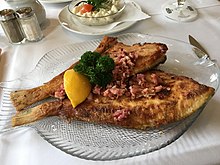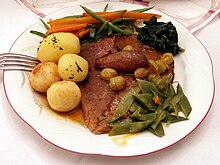Cuisine of Hamburg

Due to its centuries-old history as a major port town the cuisine of Hamburg is very diversified and sapid as ingredients' supply was safe. Until the 20th century, the cuisine of
Historical aspects

For much of its history Hamburg has been a major trading hub, resulting in both the development of a wealthy
Regional cuisine
Fish dishes

Due to its location on the
Soups and stews

One of the most popular soups in Hamburg, is the creamy lobster soup called Hamburger Hummersuppe which is served with a small amount of whipped cream and garnished with
Snack food


Like in any larger city, there is a great variety of snacks available in Hamburg. Apart from international products like
Main dishes

A main dish of Hamburg cuisine which originates in the bourgeois cuisine owes its development to the intensive trade with
Dessert

Typical sweet dishes of the cuisine of Hamburg are
Baked goods


The original
Candy and sweets

Hamburger Speck is a sort of candy made out of foamed sugar with various coatings. The color is often reminiscent of the colors of Hamburg, red-white-red. The name refers to the similarity with bacon (or speck).[7]
Drinks
Beer
Beer has been brewed in Hamburg since the early 14th century. In the year 1375 there were 457 breweries, 270 of which also exported beer. The yearly production was about 170.000 hectoliters. In the centuries that followed beer exports increased due to quality enhancements because of production changes (more wheat beer was produced and the production of dark beer and red ale decreased). The recipe was guarded like a secret treasure and since the time of the Hanseatic League which opened the trade the export of beer formed the base of Hamburg's wealth, the city being considered the 'brewery of the Hanse'.[8] In the 16th century 600 breweries are noted in historical sources which exported the beer as far as Sweden and Russia and since the 17th century even bock beer was exported from Hamburg. In the 18th century both production and export decreased and the beer market did not recover until the fast growth of population in the late 19th century. In 1890 there were only 32 breweries and nowadays there are only two old breweries in existence, the Holsten Brewery and the Gröninger brewery.[9]
Spirits
The predominant kinds of schnapps until the mid of the 20th century were Köm, the northern German version of Aquavit or Korn (distilled from rye or wheat). The small island of Neuwerk in the North Sea, which belongs to Hamburg, is famous for producing its own Aquavit. Especially the trade with South America brought Rum to the city and is featured in the Grog, a popular drink not only amongst seamen.
Import of wine
The main focus was laid on the import of wines from Médoc which were stored in barrels with little temperature variabilities in a humid and foggy climate to mature and incorporated the typical 'Rotspon' flavor.
Import of coffee and tea
The different varieties of
Even nowadays, the majority of the coffee and tea import of Germany is managed by the port of Hamburg. The varieties are also mixed (and in case of coffee beans roasted) in Hamburg and are then distributed all over Germany and other parts of continental Europe.
References
- ^ Hamburg wieder die Hochburg der Sterneköche Archived 2010-05-26 at the Wayback Machine; retrieved, 12 February 2010)
- ^ Ernst Finder: Hamburgisches Bürgertum in der Vergangenheit. Hamburg 1930, Seite 253
- ^ Rita Bake, Birgit Kiupel: Sach- und Gefühlslexikon in alphabetischer Reihenfolge von Abschied bis Zuckerbäcker. Hamburg 1987, Seite 75
- ^ Otto Benecke: Vom Lachs-Essen auf Wikisource
- ^ siehe Hamburgisches Kochbuch von 1798, zitiert nach Rita Bake, Birgit Kiupel: Sach- und Gefühlslexikon in alphabetischer Reihenfolge von Abschied bis Zuckerbäcker, Hamburg 1987, Seite 19
- ISBN 3-8319-0179-1, Seite 83
- ISBN 978-3-8319-0373-3, p. 295
- ^ Jörgen Bracker: Die wirtschaftliche Bedeutung des Bierexports. In: Hamburg. Von den Anfängen bis zur Gegenwart. Wendemarken einer Stadtgeschichte, Hamburg 1988, Seite 64 f.
- ^ Wir über uns Archived 2012-01-07 at the Wayback Machine
- ISBN 3-8319-0179-1, Seite 263

